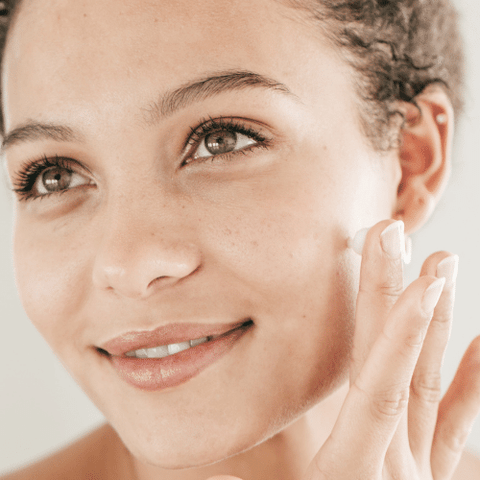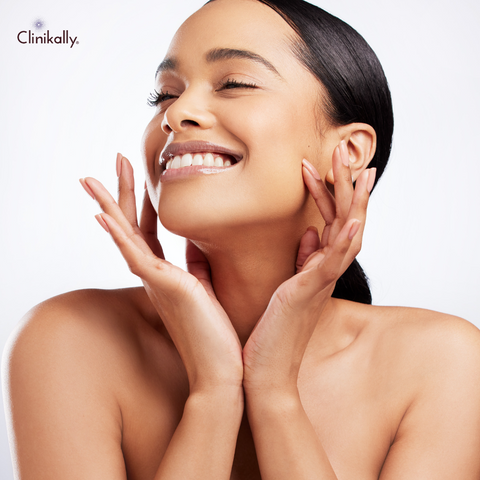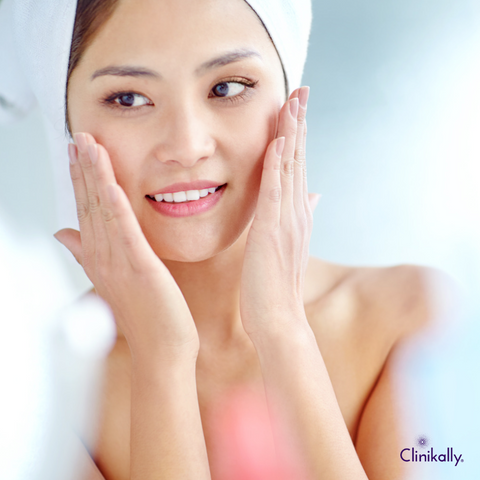Polyhydroxy acids (PHAs) are exfoliating acids with a larger molecular structure than alpha-hydroxy acids (AHAs) and beta-hydroxy acids (BHAs). Because of their gentle exfoliating and hydrating properties, PHAs are an excellent choice for those with sensitive skin. PHAs exfoliate the skin gently and aid in the removal of dead skin cells. PHAs have a larger molecular structure than other exfoliating acids, which prevents them from penetrating too deeply into the skin, making them less likely to cause irritation or inflammation. By removing dead skin cells and promoting cell turnover, PHAs can help to improve the texture and tone of the skin. They can also hydrate and plump the skin, making it look younger and more radiant.
PHAs are a good choice for people who have sensitive skin or who have had irritation or inflammation from other types of exfoliating acids. They're also a good choice for people who have dry or dehydrated skin because they have hydrating properties that can help plump and moisturize the skin. PHAs can be found in a wide range of skincare products, such as cleansers, toners, serums, and moisturizers. They work similarly to other exfoliating acids in that they are applied to clean, dry skin and left on for a set amount of time before being rinsed off. To avoid irritation, it is critical to follow the instructions on the product packaging and to patch test before use.
What is Polyhydroxy Acid and How Does it Work?

Polyhydroxy acids (PHAs) are a type of chemical exfoliant that removes dead skin cells from the skin's surface. PHAs are similar to alpha- and beta-hydroxy acids (AHAs and BHAs), but they have a larger molecular structure that makes them gentler on the skin. One advantage of PHAs is that their molecular size is larger than that of other exfoliating acids, which means they do not penetrate as deeply into the skin. As a result, they are less likely to cause irritation or inflammation, making them an excellent choice for those with sensitive skin. PHAs are also hydrating, which means they can help to improve the moisture content of the skin and promote a plump, youthful appearance. This is due to the fact that PHAs are humectants, which help to draw moisture into the skin.
Understanding Polyhydroxy Acid
PHAs are known for their gentle exfoliating and hydrating properties, making them an excellent choice for those with sensitive skin. PHAs have a larger molecular structure than other exfoliating acids, which prevents them from penetrating too deeply into the skin, making them less likely to cause irritation or inflammation.
PHAs are also hydrating, which means they can help the skin retain moisture and promote a plump, youthful appearance. They work by attracting water molecules to the skin, keeping it hydrated and supple. PHAs can be found in a wide range of skincare products, such as cleansers, toners, serums, and moisturizers. They work similarly to other exfoliating acids in that they are applied to clean, dry skin and left on for a set amount of time before being rinsed off. To avoid irritation, it is critical to follow the instructions on the product packaging and to patch test before use.
Benefits of Polyhydroxy Acid for Skin
Polyhydroxy acids (PHAs) have several skin benefits:
-
Gentle exfoliation: PHAs are gentle exfoliators, which makes them ideal for people with sensitive skin. They work by dissolving the bonds between dead skin cells, allowing them to be easily removed from the skin's surface, revealing smoother, brighter, and more even-toned skin.
-
Hydration: PHAs have hydrating properties, which means they can help to improve the skin's moisture content and promote a plump, youthful appearance. They work by attracting water molecules to the skin, keeping it hydrated and supple.
-
Anti-aging: PHAs have been shown to help reduce the appearance of fine lines, wrinkles, and other signs of aging. They work by increasing cell turnover and collagen production, which improves skin elasticity and firmness.
-
Anti-inflammatory: PHAs have anti-inflammatory properties, which means they can help to reduce redness, swelling, and other signs of inflammation in the skin.
-
Sun damage repair: PHAs have been shown to aid in the repair of sun damage, such as hyperpigmentation and uneven skin tone. They work by exfoliating the top layer of the skin, removing dead and damaged skin cells and encouraging new cell growth.
How Does Polyhydroxy Acid Compare to Other Types of Exfoliants?
Polyhydroxy acids (PHAs) are a type of chemical exfoliant that is similar to alpha-hydroxy acids (AHAs) and beta-hydroxy acids (BHAs), but there are some significant differences. Comparing them is as follows:
-
Molecular size: PHAs have a larger molecular size than AHAs and BHAs, which means they don't penetrate as deeply into the skin. They are therefore less likely to irritate people with sensitive skin, making them a good option.
-
Exfoliation: When compared to AHAs and BHAs, PHAs offer a gentler exfoliation. Dead skin cells slough off as a result of the action of AHAs and BHAs, which dissolve the bonds holding them together. PHAs, on the other hand, function by dissolving the bonds that hold dead skin cells together, making it simple to remove them from the skin's surface.
-
Hydration: PHAs hydrating qualities enable them to increase the moisture content of the skin and promote a plump, youthful appearance. AHAs and BHAs can be drying, especially if used too frequently.
-
Sun sensitivity: AHAs and BHAs may make the skin more susceptible to sun damage by making it more sensitive to the sun. It has been demonstrated that PHAs are less likely to cause sun sensitivity.
Who Should Use Polyhydroxy Acid Skincare Products?

Skincare products containing polyhydroxy acids (PHAs) are suitable for a wide range of users, but they are especially helpful for those with sensitive skin or those who have previously experienced irritation or inflammation from other types of exfoliating acids. PHAs are mild exfoliants that work by dissolving the bonds that hold dead skin cells together, making it easier to remove them from the surface of the skin. They offer advantages compared to those of alpha- and beta-hydroxy acids (AHAs and BHAs), but with less irritation risk.
PHAs are an excellent option for people with dry, sensitive, or acne-prone skin because they are not only exfoliating but also hydrating and anti-inflammatory. To make sure your skin can tolerate it, patch-test it first and start with a low concentration, as you should with any skincare product. Sunscreen should always be worn when using PHA products because they may make your skin more susceptible to the sun's rays.
Polyhydroxy Acid for Sensitive Skin
Polyhydroxy acid (PHA) is a great option for those with sensitive skin who want to incorporate an exfoliant into their skincare routine. PHAs are milder than other exfoliating acids, such as alpha-hydroxy acids (AHAs) and beta-hydroxy acids (BHAs), making them less likely to cause irritation or inflammation. PHAs work by breaking down the bonds between dead skin cells, allowing them to be easily removed from the surface of the skin. This helps to improve skin texture and tone, as well as reduce the appearance of fine lines and wrinkles. Additionally, PHAs have hydrating and anti-inflammatory properties, making them a good option for those with dry or sensitive skin.
When using PHA products, start with a low concentration and perform a patch test to ensure that your skin can tolerate it. As your skin adjusts, you can gradually increase the concentration. When using PHA products, it's also important to wear sunscreen because it can make your skin more sensitive to the sun.
Polyhydroxy Acid for Anti-Aging and Hyperpigmentation
Polyhydroxy acid (PHA) has been shown to be effective in treating skin ageing and hyperpigmentation. PHAs exfoliate the skin and stimulate cell turnover, which can improve skin texture and tone, reduce the appearance of fine lines and wrinkles, and fade dark spots and hyperpigmentation. PHAs have hydrating and anti-inflammatory qualities in addition to exfoliating, making them a fantastic option for people with dry or sensitive skin. Since dryness and inflammation can make fine lines and wrinkles appear worse, this is particularly crucial for people who are worried about their appearance.
When using PHA products for anti-aging and hyperpigmentation, it is important to be patient and consistent with your routine. It may take several weeks or months for results to become apparent, and continued use is required to maintain results. It's also a good idea to patch test first and start with a low concentration to make sure your skin can handle it. Increasing the concentration gradually over time can help to reduce the risk of irritation or inflammation.
Polyhydroxy Acid for Acne-Prone Skin
Polyhydroxy acid (PHA) can be an effective treatment for acne-prone skin. PHAs work by exfoliating the skin and accelerating cell turnover to clear clogged pores, stop the development of new pimples, and lessen the visibility of existing pimples. PHAs are less likely to cause irritation or inflammation than other exfoliating acids such as alpha-hydroxy acids (AHAs) and beta-hydroxy acids (BHAs). This is particularly crucial for acne-prone skin because irritation and inflammation can make acne worse.
PHAs are a great option for people with dry or sensitive skin because they are not only exfoliating but also hydrating and anti-inflammatory. This may be advantageous for those with acne-prone skin because many acne treatments can be drying and irritating to the skin. If you have acne-prone skin, start with a low concentration of PHA products and conduct a patch test to see if your skin can withstand them. The risk of irritation or inflammation can be decreased by gradually raising the concentration over time.
How to Incorporate Polyhydroxy Acid into Your Skincare Routine?

You should keep a few things in mind to use polyhydroxy acid (PHA) safely and effectively if you're interested in incorporating it into your skincare regimen.
-
Start with a low concentration: To prevent irritation or inflammation, it's crucial to start using PHA at a low concentration. Try to find products with a 5% or lower concentration.
-
Patch test first: Before using a new PHA product all over your face, do a patch test on a small area of your skin to make sure that you don't have any adverse reactions.
-
Introduce it gradually: To give your skin time to adjust, it's important to introduce new skincare products gradually. PHA product usage should be gradually increased from once per week to two or three times per week as tolerated.
-
Follow with sunscreen: PHA can increase sun sensitivity, so it's important to always follow up with a broad-spectrum sunscreen with at least SPF 30 during the day.
-
Consider your skin type: While PHA is typically tolerated by all skin types, its hydrating and anti-inflammatory properties may be especially helpful to those with dry or sensitive skin. Its pore-cleansing advantages might also be useful for people with oily or acne-prone skin.
-
Use in conjunction with other skincare products: PHA can be used in conjunction with other skincare products, such as vitamin C serums or retinoids, to address a range of skincare concerns.
Tips for Using Polyhydroxy Acid Products
Here are some tips for using polyhydroxy acid (PHA) products:
-
As with any new skincare product, start with a low concentration to avoid irritating or damaging your skin. Begin with a product that has a PHA concentration of 5% or less and gradually increase the concentration over time if needed.
-
Always follow the directions on the product packaging. Some PHA products may need to be rinsed off after a certain amount of time, while others may be left on overnight.
-
PHA products work best when used consistently. Use the product as directed and be patient, as it may take several weeks or even months to see results.
-
While PHA is a gentle exfoliant, over-exfoliating can still occur if you use the product too frequently or with other exfoliating products. Stick to using PHA once or twice a week to avoid over-exfoliating.
-
Apply sunscreen immediately after using a PHA product, even if you plan to stay indoors because PHA can make your skin more sensitive to the sun.
-
PHA can be combined with other skincare products, such as vitamin C or retinol, to help address multiple skin concerns. However, be cautious when combining multiple products and start with one new product at a time to avoid irritation.
Combining Polyhydroxy Acid with Other Skincare Ingredients
In order to develop a thorough skincare routine that addresses various skin concerns, polyhydroxy acid (PHA) can be combined with other skincare ingredients. The following common skincare components blend well with PHA:
-
Vitamin C: An antioxidant that helps lighten skin and lessen the appearance of hyperpigmentation and dark spots is vitamin C. It can help enhance the skin's overall texture and appearance when combined with PHA.
-
Retinol: A vitamin A derivative that helps reduce the appearance of wrinkles, fine lines, and other aging signs. PHA can help soothe and hydrate the skin, making it a great combination for those with sensitive skin.
-
Niacinamide: A form of vitamin B3 known as niacinamide aids in reducing inflammation and enhancing the look of pores. It can be used in conjunction with PHA to produce a mild exfoliating and pore-reducer effect.
-
Hyaluronic Acid: A hydrating substance, hyaluronic acid helps to strengthen the skin's moisture barrier. It can help calm and hydrate the skin while also gently exfoliating when combined with PHA.
It is essential to add PHA to other skincare ingredients gradually and one at a time. Start with one new ingredient and use it for a few weeks before introducing another to prevent potential sensitivity or irritation. Follow the product directions carefully, and if you have any questions, seek the advice of a dermatologist.
Polyhydroxy Acid vs. Chemical Peel: Which One is Right for You?

Both polyhydroxy acid (PHA) and chemical peels are exfoliating procedures that can enhance the skin's overall look and texture. They serve various functions and have different workings, though. The main variations between the two are as follows:
-
Strength: Compared to PHA, chemical peels are typically more powerful and aggressive. They can produce more dramatic results and penetrate deeper into the skin to remove more layers of dead skin cells. The milder exfoliant PHA, on the other hand, is suitable for people with sensitive skin.
-
Application: PHA products can be used at home, whereas chemical peels are typically applied by a dermatologist or other skincare expert. PHA products are typically gentler and have fewer side effects than chemical peels, which may require downtime and can cause skin irritation, redness, and peeling.
-
Targeted issues: Skin conditions like acne, hyperpigmentation, and fine lines and wrinkles are frequently treated with chemical peels. PHA, on the other hand, can be used to exfoliate the skin generally and to enhance the skin's overall texture and appearance.
-
Frequency: Chemical peels are typically done every few months, while PHA products can be used more frequently, depending on the product and the individual's skin type and concerns.
PHA may be a better choice for you in general if you have sensitive skin or are looking for a gentler exfoliating treatment. However, a chemical peel might be more suitable if you have specific skin issues that call for more forceful treatment. To choose the best course of action for your skin, it's always a good idea to speak with a dermatologist or skincare expert.
Differences Between Polyhydroxy Acid and Chemical Peel
Polyhydroxy acid (PHA) and chemical peels are both exfoliating treatments that can improve the overall appearance and texture of the skin. However, they work differently and are used for different purposes. First, you have your AHAs (alpha-hydroxy acids), which include glycolic, citric, and lactic acids. They each have their own unique strengths, but they all work by nibbling away at skin cells to reveal more glowing skin beneath. Because AHAs can be quite potent, you should probably limit your use to once or twice a week, depending on the concentration of your product. As always, start slowly and see how things go. Then there are BHAs, or beta-hydroxy acids, which contain salicylic acid. This type of acid is excellent at flushing out blocked pores, which is why it is frequently recommended for acne or keratosis pilaris—that rough skin you have that never seems to go away.
Which Skincare Treatment Should You Choose?
Your skin concerns, skin type, and overall skincare objectives will determine whether you choose polyhydroxy acid (PHA) or chemical peels. Here are some things to think about:
-
Skin type: PHA may be a better option if you have sensitive skin or are prone to irritation because it is kinder and less likely to irritate you. On the other hand, chemical peels can be more aggressive and might not be appropriate for people with sensitive skin.
-
Skin problems: A chemical peel might be a better option if you have particular skin issues like acne, hyperpigmentation, or fine lines and wrinkles. Chemical peels are more potent and can treat specific skin issues with more dramatic results. PHA, on the other hand, works better at improving the texture of the skin and general exfoliation.
-
Downtime: While PHA products can typically be used every day with no downtime, chemical peels frequently require downtime for the skin to heal and recover.
-
Cost: Chemical peels are often more expensive than PHA products, and they may require more sessions to achieve desired results.
The choice between PHA and chemical peels will ultimately depend on the issues, concerns, and skincare goals specific to your skin. To find the best course of action for your skin, it's always a good idea to speak with a dermatologist or skincare expert.
















